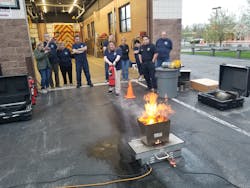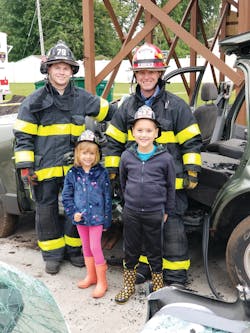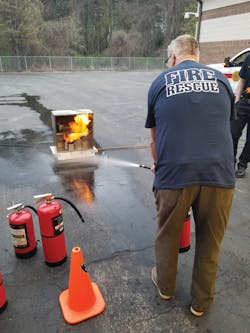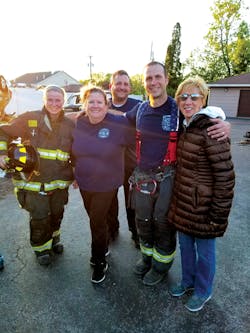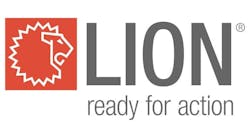Connecting with your community is as important as responding to the 9-1-1 calls we receive each day, regardless if you are a major metro department or a smaller organization. At the Gates, NY, Fire District, we have an aggressive community outreach program that allows us to educate the children in our schools and meet the people we serve daily.
Building relationships
The Gates Fire District has approximately 29,000 residents, and this number increases to close to 100,000 at peak times during the work week. We serve a 20-square-mile area that includes a medium-sized school district, a growing senior citizen population and a large commercial area.
We have a combination department that consists of about 50 paid and 20 volunteer firefighters and two paid community risk reduction specialists who staff three fire stations. On average we run about 4,300 calls per year.
We recently held our first Citizen’s Fire Academy, which ran for 10 weeks on Monday evenings. The objective of this program was to help our community understand what their fire department is all about. Over this 10-week period, we had both paid and volunteer firefighters work with the group explaining and demonstrating a variety of their regular work activities. They did everything from CPR, maze work, rope training, extrication, participated in the national Stop the Bleed training and much more.The comments we heard were the same over and over each week: “I can’t believe you do this!”, “I did not realize you respond to more than just fires!” and “You go on medical calls, too?”. They were unaware of the many functions performed by today’s firefighter. This training program provided us the opportunity to open the doors of the fire station, increase transparency and demonstrate exactly what we do. What better way to connect with our citizens? Ask yourself this: Do your citizens truly know what you do?
Our citizens are ultimately the main stakeholders who must be convinced when we are putting together our yearly budget. Strong relationships need to be built to create an understanding within the public, because without the buy-in from them, there could be some pushback, especially when they are not educated as to what goes on day to day.
Outreach programs
Our program, however, goes much further than this. We have partnered with the American Red Cross of Western and Central New York. The Red Cross provides our department with free smoke alarms and we simply install them in the community. Alarms can be installed by appointment or if the situation allows, after a call is completed.Taking a few moments to show care and concern goes a long way. When your crew is out there installing smoke alarms, it accomplishes many goals; for example, it demonstrates interest in the well-being of your citizens.
You should have some statistics readily available that will prove the reason why they should continue maintaining their alarms. According to the U.S. Fire Administration, for example, three out every five houses do not have a working smoke alarm. Installing these devices increases the chance of surviving a fire by about 50 percent. Before you know it, through word of mouth, it’s possible that you will be requested back to help other neighbors as well.
This outreach program is also important after a fire. Within 24 hours of a fire, we are back on the street talking with neighbors and asking to check their smoke alarms. Why is this beneficial? People have questions about what they saw happening to their neighbor. Without going into the specifics about the fire, residents can be educated on how to prevent fires in their homes. Draw their attention to preventative measures that can be taken while not embarrassing the affected family. You have started an important conversation, and before you know it, your department has made another friend through the installation of a smoke alarm. As an important note, be sure to have a liability waiver for the homeowners to sign on all installs.
Taking care of business(es)
What about your local businesses? Should you have a plan for them? They deserve the same level of service as residents. What can you do to help them? How about conducting a fire drill? Most businesses must provide fire safety training each year for their employees—take time to schedule an appointment prior to the fire drill to understand the operation of the business and get to know the people who work there. Meeting with the staff prior to the fire drill assures them you are not there to inspect or judge. Go in explaining that you are there to educate the staff and provide the training they need.
When conducting a fire drill, we use the fire codes to help establish guidelines on what we look at during the drill. This helps in two ways. First, by proving to the manager we are following already established procedures when a fire drill is performed. Second, a report can be developed which documents the fact that they successfully accomplished the drill. Upon completion, this drill created a relationship where trust was instantly formed.If you have access to a fire extinguisher simulator, consider preparing a lesson plan to deliver on fire safety. Our district uses the Bull Ex Fire Extinguishing System. It is easy to assemble and safe to use. In addition, since it uses water to extinguish the fire, it keeps everyone and the area you are training in clean. You may have a different system, but the message is always the same. It is best to start in a classroom setting explaining statistics, science, classes of fire, evacuation procedures and general fire safety. Plan on receiving a lot of questions during the classroom segment of the training. Always be honest and answer the questions to the best of your knowledge. If you do not know the answer to a question, let them know you will find out and get back to them with the answer. Many times, attendees will ask about fire safety in their homes. This is useful information for them—they trust your knowledge and want your input. Conclude the lesson with a simple reminder about the importance of working smoke alarms.
An effective team-building activity, the hands-on portion comes next. While teaching, you are connecting with them through this interactive lesson. Although, you must stress, putting out fires is never the first priority. Activating the alarm, evacuating the building and notifying/updating the fire department is paramount. Discuss the proper technique for using a fire extinguisher, such as the P.A.S.S. system. Participants need to be familiar with extinguishers before using them. Allow everyone the opportunity to operate the extinguisher. Explain when using an extinguisher, it is never to attack the fire but simply to clear the path to evacuate.
Mutually beneficial
What have you gained from these programs? You have built up equity with your local business as their community risk reducer. They will call you again when they have questions because they know there is no agenda other than to keep their employees safe and you have reduced the chances of an injury or fatality.Getting to this point does not come without putting forth some effort. When I was first hired, I remember having some ideas on what to do, however, I needed not only organizational equity from my bosses, but community equity as well. This is the ability to obtain support from different groups from within the area you serve.
Finally, you must understand the importance of your role in the community you serve. You are a leader who many people look up to and trust. Creating this bond with them depends on you being honest and not breaking their trust. You cannot possibly have all the answers all the time, but you certainly can find them. We have seen a downward trend of fires within our district over the years, however, we cannot entirely focus on just fires anymore. As community risk reducers, we must consider all the risks. By taking the time to find out about the risks that could affect your communities and by working to change behaviors, you will ultimately prove your department’s care for its citizens. This will strengthen the relationships you are trying to develop.
You must take small steps toward this goal because it will not happen quickly. It will take hard work and dedication to have a successful relationship. I am lucky enough to work in a department that is 100 percent committed to working toward this goal. You need to get the same buy-in from your leadership to make it happen as well.
One way to learn more about community risk reduction programs and developing these relationships is to attend the National Fire Academy (NFA) in Emmitsburg, MD. This is a tremendous resource for the fire service that is available to all firefighters. Attending the NFA will help you succeed in creating these bonds and reducing the risks. Not only will you benefit from the education you will receive, but you will begin a lifetime of networking with your classmates. As always, remember education, prevention and protection are the building blocks to a safer community.

Joseph Manuse
Joseph Manuse has been the career Community Risk Reduction Specialist for the Gates, NY, Fire District since 2008. He has been a volunteer firefighter with the Gates-Chili Fire Department for almost 28 years, holding the ranks of lieutenant, captain and assistant chief. As the Community Risk Reduction Specialist, he is responsible for providing various fire prevention and fire safety lessons through community outreach programs within the Gates-Chili School District, local businesses and senior centers. Manuse regularly conducts fire extinguisher/fire safety programs with many of the local businesses, assists with fire evacuation drills, and conducts a Junior Fire Academy every summer for middle school students. In addition, Manuse regularly attends training classes at the New York State Fire Academy and the National Fire Academy to maintain his certifications. In addition to his regular job responsibilities, he has obtained certifications as a building safety inspector, Fire Instructor I and Fire Instructor II and received an associate of applied science degree in fire protection technology. Manuse received the 2016 Raymond Emma Fire Educator of the Year Award.
